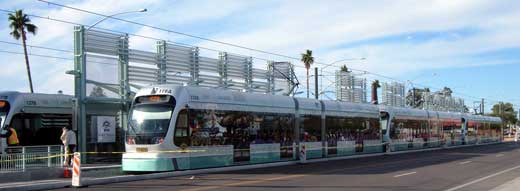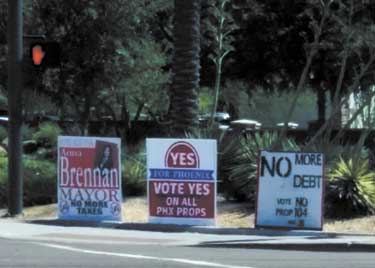BY LINDA BENTLEY | AUGUST 5, 2015
Prop 104 – A 35-year, $31.5 billion boondoggle with no accountability
Everyone pays for light rail in Phoenix but the fact is less than 1 percent of those in Phoenix who use public transit, use light rail

PHOENIX – On Aug. 25, Phoenix voters will decide if they want to pass Proposition 104 and increase their current transit tax from 0.4 percent to 0.7 percent (75 percent increase) primarily to expand the already heavily subsidized Metro light rail.
Anna Brennan, a conservative running against Mayor Greg Stanton, who was catapulted into office with union backing, is running on a platform of “No more taxes.”
Brennan is a naturalized citizen originally from Italy, with a degree in nursing, a pilot’s license, a member of the National Charity League and a successful business owner.
Brennan claims light rail across the country has failed to decrease traffic congestion, automobile usage, travel times and air pollution while it operates at steep losses, which taxpayers must subsidize.
Randal O’Toole from the Cato Institute prepared a report to point out the inefficiencies of light rail but also noted, “The proposed sales tax increase will bring in about $7 billion, which is the cost of the proposed new light rail lines.
“In other words, without raising the sales tax, Phoenix could fund everything in the transportation plan except the light rail expansion.”
However, O’Toole also said, “If they build more light rail, inevitable cost overruns will prevent the city from keeping many other promises made in the plan.”
But those promises aren’t really promises, as District 6 Phoenix City Councilman Sal DiCiccio points out.
DiCiccio, who vehemently opposes all four of the city’s ballot propositions, warned that Stanton and his cronies inserted the word “may” at the last minute to deceive voters and the language states: “The revenues raised may be spent for activities including the following …”
 So, all the projects enumerated in Prop. 104 are only a maybe, which means the 75 percent transit sales tax increase for 35 years is basically giving Phoenix a blank check.
So, all the projects enumerated in Prop. 104 are only a maybe, which means the 75 percent transit sales tax increase for 35 years is basically giving Phoenix a blank check.
DiCiccio said, in addition to “nefariously inserting the word ‘may’ into the ballot language,” Stanton and his colleagues struck a last-minute “backroom deal” that “gave big business a $300 million exemption from the $31.5 billion tax, forcing citizens and small business owners to pay the entire tax; passed a budget giving first-year employees 40.5 days off; and budgeted new pay raises and bonuses to everyone ... increasing average compensation for all employees to over $109,000 per year.”
Everyone pays for light rail in Phoenix but the fact is less than 1 percent of those in Phoenix who use public transit, which only constitutes 3 percent of the population, use light rail.
And, since the light rail line was first introduced in Phoenix, ridership has fallen.
Meanwhile, Highway User Revenue Fund (HURF) money, collected at the pump via gas taxes, is being used to help fund light rail, which is run on electricity; bike lanes; and other such projects, creating road users that do not pay into the HURF, which obligates funds it doesn’t have to pay for them.
O’Toole stated, “Light rail is a slow, expensive, obsolete technology; buses can move people faster, safer, and at far lower cost than rail. Rail’s only virtue is that it costs more and thus creates more political favors.”
He said transit is “irrelevant” to most Phoenix-area residents.
And while those seeking to pass Prop. 104 claim light rail stimulates development and promotes urban growth, O’Toole said, “In order to claim that light rail generated $8.2 billion in economic development, Valley Metro simply counted all of the new or planned developments (some of which may never be built) within half a mile of a light rail station.
“In fact, all of the completed developments would have taken place somewhere in Phoenix without the light rail; at most, all light rail did is influence their location.”
O’Toole indicated the proposal does not reduce congestion and said, “Even if every transit rider were to switch to driving, the impact on traffic would be negligible.”
There is even something for the “climate change” crowd as well, with O’Toole stating, “The transit plan as proposed will increase energy usage and greenhouse gas emissions. It is more harmful per passenger mile than the average SUV, and automobiles are rapidly becoming more energy efficient.”
According to O’Toole, new transportation technologies in the not too distant future will make most transit obsolete, leaving Phoenix saddled with a 75 percent increase in its transit sales tax for the next 35 years to continue to fund already obsolete technology.



